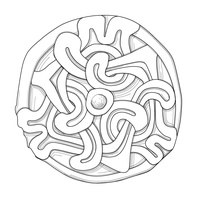
Viking Designs
Drawing of Copper Alloy Disc Brooch
Drawing of a copper alloy, gilded brooch with a zoomorphic design. Brooches were a typical part of female dress. Scandinavian brooches came in a variety of sizes and shapes which included disc, trefoil, lozenge, equal-armed, and oval shapes. The different brooch types served a variety of functions in Scandinavian female dress with oval brooches typically being used as shoulder clasps for apron-type dresses and the rest being used to secure an outer garment to an inner shift. Anglo-Saxon brooches do not match this diversity of form with large disc brooches being typical of ninth century dress styles with smaller ones becoming more popular in the later ninth and tenth centuries. However, since disc brooches were used by both Anglo-Saxon and Scandinavian women they are distinguished by their morphology. Scandinavian brooches were typically domed with a hollow back while Anglo-Saxon brooches were usually flat. Moreover, Anglo-Saxon brooches were worn singly without accompanying accessories.
Read More
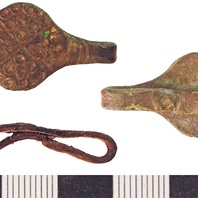
Viking Objects
Imitation Finger Ring (NLM-D675CA)
This finger ring bears stamped decoration imitating the Scandinavian ring and dot pattern which is bordered by incised crossing diagonals of a saltire. The ring- and dot-style of decoration was briefly adopted by inhabitants of Anglo-Saxon settlements such as Cottam in Yorkshire and Flixborough in Lincolnshire.
Read More
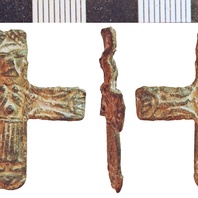
Item
Crucifix Pendant (NLM-AD60CD)
The settlement of Scandinavians in the Danelaw inevitably led in the end to their conversion to Christianity, though how this process happened and how long it took varied in different parts of the country and is still not fully understood. Finds from Scandinavian-settled areas, like this crucifix with a clear image of Christ on the cross, may well be evidence for this process.
Read More
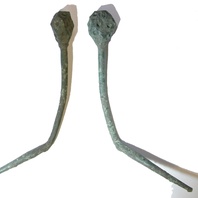
Viking Objects
Ring-and-Dot Pin (1986/976-SF4)
This copper alloy pin with a ring-and-dot pattern on the head was used for fastening cloaks. It was found on the site of Little Chester Roman fort. Pins like this were common in Ireland and the western British Isles, and spread further afield under Viking influence.
Read More
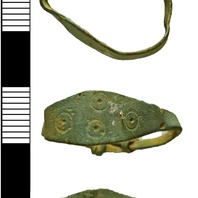
Viking Objects
Stamped Finger-Ring (NARC-031C88)
A stamped copper-alloy finger ring decorated with four double ring-and-dots in a lozengiform arrangement. Ring-and-dot was a decorative technique used at various periods from the later Iron Age onwards, but which enjoyed a Viking Age revival. Rings like this with knotted ends are typically Scandinavian.
Read More
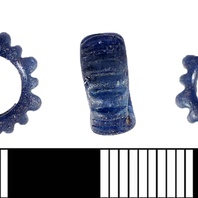
Viking Objects
Glass Bead (PUBLIC-170BD9)
This monochrome glass bead is blue coloured and has a decorative edging in a reed like pattern. Similar beads have been found in other Anglo-Scandinavian contexts. Glass beads were, generally, used in necklaces or similar jewellery and were highly prized among Scandinavians.
Read More
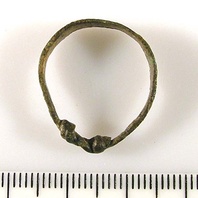
Viking Objects
Copper-Alloy Finger-Ring (LIN-E42F77)
The ring is formed by a flat band tapering to ends which have been knotted together. The outer face of the band is decorated with a row of punched ring and dot motifs.
Read More
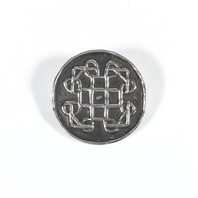
Viking Objects
Reproduction Terslev Brooch
This Borre-style brooch has been identified by Jane Kershaw as a Terslev Type V variant. Terslev style, where Scandinavian ring-chain patterns are the main decorative component, is a subcategory of the Borre style and takes its name from the silver hoard discovered in Terslev, Denmark. The decoration comprises a series of ring-knots related to the Borre ring-chain. The Terslev style occurs mainly on brooches and pendants, including both high-quality gold and silver jewellery as well as lower-end base-metal items. The cast base-metal ornaments, such as those made of copper alloy, were intended to imitate the higher-end gold and silver jewellery, and often employed techniques such as gilding to achieve this. The Terslev designs that occur in England extend the repertoire by introducing new Scandinavian motifs hitherto unrecorded in Scandinavia. For more information on Scandinavian jewellery in England check out our blog: Brooches, Pendants and Pins: Scandinavian Dress Accessories in England.
Read More
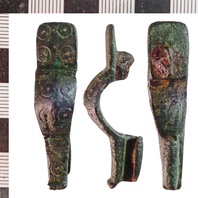
Viking Objects
Copper-Alloy Ansate Brooch (NLM-AED2E2)
The design of these brooches is a variant known as ‘caterpillar’ type which is typically geographically limited to areas bordering the North Sea, though the quantity found in England may indicate local manufacture. The original design of the brooch has a Carolingian origin. Ansate brooches are dated to between the seventh and ninth centuries though the finds at Coppergate in York may extend their popularity into the tenth century. It is possible that this particular example made its way to England prior to Viking incursions but it is equally likely that the Vikings brought this brooch with them as plunder after raiding in Frankia. For more information on Scandinavian jewellery in England check out our blog: Brooches, Pendants and Pins: Scandinavian Dress Accessories in England.
Read More
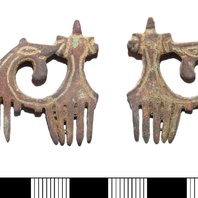
Viking Objects
Comb Pendant (LIN-DD07D2)
The pendant is decorated with two inturned zoomorphic heads executed in Ringerike-style ornament. These comb-shaped pendants are closely paralleled in the area around the Baltic Sea such as northwest Russia, Finland, Latvia and Lithuania, with rare examples from Estonia and Sweden. Pendants were a popular dress accessory in Norway and Sweden and sometimes were worn with beads between a pair of oval brooches. In England, pendants did not have the same popularity and there do not seem to be any contemporary Anglo-Saxon pendants.
